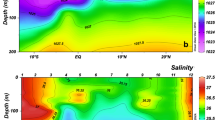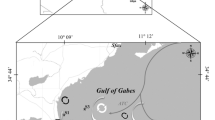Abstract
Based on existing knowledge about phytoplankton responses to nutrients and food size spectra of herbivorous zooplankton, three different configurations of pelagic food webs are proposed for three different types of marine nutrient regimes: (1) upwelling systems, (2) oligotrophic oceanic systems, (3) eutrophicated coastal systems. Upwelling systems are characterised by high levels of plant nutrients and high ratios of Si to N and P. Phytoplankton consists mainly of diatoms together with a subdominant contribution of flagellates. Most phytoplankton falls into the food spectrum of herbivorous, crustacean zooplankton. Therefore, herbivorous crustaceans occupy trophic level 2 and zooplanktivorous fish occupy trophic level 3. Phytoplankton in oligotrophic, oceanic systems is dominated by picoplankton, which are too small to be ingested by copepods. Most primary production is channelled through the `microbial loop' (picoplankton – heterotrophic nanoflagellates – ciliates). Sporadically, pelagic tunicates also consume a substantial proportion of primary production. Herbivorous crustaceans feed on heterotrophic nanoflagellates and ciliates, thus occupying a food chain position between 3 and 4, which leads to a food chain position between 4 and 5 for zooplanktivorous fish. By cultural eutrophication, N and P availability are elevated while Si remains unaffected or even declines. Diatoms decrease in relative importance while summer blooms of inedible algae (Phaeocystis, toxic dinoflagellates, toxic prymnesiophyceae, etc.) prevail. The spring bloom may still contain a substantial contribution of diatoms. The production of the inedible algae enters the pelagic energy flow via the detritus food chain: DOC release by cell lysis – bacteria – heterotrophic nanoflagellates – ciliates. Accordingly, crustacean zooplankton occupy food chain position 4 to 5 during the non-diatom seasons. Ecological efficiency considerations lead to the conclusion that fish production:primary production ratios should be highest in upwelling systems and substantially lower in oligotrophic and in culturally eutrophicated systems. Further losses of fish production may occur when carnivorous, gelatinous zooplankton (jellyfish) replace fish.
Similar content being viewed by others
References
Azam, F., T. Fenchel, J. G. Field, L. A. Meier-Reil & F. Thingstad, 1983. The ecological role of water column microbes in the sea. Mar. Ecol. Progr. Ser. 10: 257-263.
Barber, R. T. & R. L. Smith, 1981. Coastal upwelling ecosystems. In Longhurst, A. R. (ed.), Analysis of Marine Ecosystems. Academic Press, London: 33-68.
Billen, G. & J. Garnier, 1997. The Phison river plume: coastal eutrophication in response to changes in land use and water management in the watershed. Aquat. Microb. Ecol. 13: 3-17.
Cadée, G. C., 1986. Recurrent and changing seasonal patterns of phytoplankton in the westernmost inlet of the Wadden Sea, the Marsdiep, since 1973. In Lancelot, C., G. Billen & H. Bath (eds), Water Pollution Research Report 12. Commission of the European Community, Luxembourg: 105-112.
Cadée, G. C. & J. Hegeman, 1991. Historical phytoplankton data from the Marsdiep. Hydrobiol. Bull. 24: 111-119.
Carpenter, S. R., J. F. Kitchell & D. R. Hodgson, 1985. Cascading trophic interactions and lake productivity. BioScience 35: 634-639.
Coale, K. H., K. S. Johnson, S. E. Fitzwater, R. M. Gordon, S. Tanner, F. P. Chavez, L. Ferioli, C. Sakamoto, P. Rogers, F. Millero, P. Steinberg, P. Nightingale, D. Cooper, W. P. Cochlan, M. R. Landry, J. Constantinou, G. Rollwagen, A. Trasvina & R. Cudela, 1996. A massive phytoplankton bloom induced by an ecosystem-scale iron fertilisation experiment in the equatorial Pacific Ocean. Nature 383: 495-501.
Cushing, J. D. H., 1971. Upwelling and the productivity of fish. Adv. Mar. Biol. 9: 255-334.
DeMott, W. R., 1988. Discrimination between algae and artificial particles by freshwater and marine copepods. Limnol. Oceanogr. 33: 397-408.
Egge, J. K. & A. Jacobsen, 1997. Influence of silicate on particulate carbon production in phytoplankton. Mar. Ecol. Progr. Ser. 147: 219-230.
Escaravage, V., T. C. Prins, A. C. Smaal, J. C. H. Peeters, 1996. The response of phytoplankton communities to phosphorous input reductions in mesocosm experiments. J. Exp. Mar. Biol. Ecol. 198: 55-79.
Granéli, E., P. Carlsson, P. Olsson, B. Sundström, W. Granéli & O. Lindahl, 1989. From anoxia to fish poisoning: the last ten years of phytoplankton blooms in Swedish marine waters. In Cosper, E. M., V. M. Bricelj & E. J. Carpenter (eds), Novel Phytoplankton Blooms. Springer, New York: 407-427.
Ianora, A., A. Miralto & S. A. Poulet, 1999. Are diatoms good or toxic for copepods? Reply to comment by Jonasdottir et al. Mar. Ecol. Progr. Ser. 177: 305-308.
Ianora, A., S. A. Poulet & A. Miralto, 1995. A comparative study of the inhibitory effect of diatoms on the reproductive biology of the copepod Temora stylifera. Mar. Biol. 121: 533-539.
Iverson, R. L., 1990. Control of marine fish production. Limnol. Oceanogr. 35: 1593-1604.
James, A. G. & X. Chiappa-Carrara, 1990. A comparison of field studies on the trophic ecology of Engraulis capensis and E. mordax. In Barnes, M. & R. N. Gibson (eds), Trophic Relationships in the Marine Environment. Aberdeen Univ. Press: 208-221.
Jonasdottir, S. H., T. Kiørboe, K. W. Tang, M. St. John, A. W. Visser, E. Saiz & H. G. Dam, 1998. Role of diatoms in copepod production: good, harmless or toxic. Mar. Ecol. Progr. Ser. 172: 305-308.
Katechakis, A., 1999. Nischenüberlappung zwischen herbivorem gelatinösen und Crustaceen-Zooplankton im NW-Mittelmeer (Catalanisches Meer). Diploma thesis, Univ. Kiel.
Kiørboe, T., E. Saiz & M. Viitasalo, 1996. Prey switching behaviour of the planktonic copepod Acartia tonsa. Mar. Ecol. Progr. Ser. 143: 65-75.
Kleppel, G. S., 1993. On the diet of calanoid copepods. Mar. Ecol. Progr. Ser. 99: 183-195.
Legovic, T., 1987. A recent increase in jellyfish-populations: A predator-prey model and its implications. Ecol. Modell. 38: 243-256.
Li, W. K. W., T. Zohary, Y. Z. Jacobi & A. M. Wood, 1993. Ultraphytoplankton in the eastern Mediterranean Sea: towards deriving phytoplankton biomass from flow cytometric measures of abundance, fluorescence and light scatter. Mar. Ecol. Progr. Ser. 102: 79-87.
Lindell, D. & A. F. Post, 1995. Ultraphytoplankton succession is triggered by deep winter mixing in the Gulf of Aqaba (Eilat), Red Sea. Limnol. Oceanogr. 40: 1130-1141.
Nejstgaard, J. C., I. Gismervik & P. T. Solberg, 1997. Feeding and reproduction by Calanus finnmarchicus, and microzooplankton grazing during mesocosm blooms of diatoms and the coccolithophore Emiliana huxleyi. Mar. Ecol. Progr. Ser. 147: 197-217.
Pomeroy, L. R., 1974. The ocean foodweb, a changing paradigm. BioScience 24: 499-504.
Radach, G. & J. Berg, 1986. Trends in den Konzentrationen der Nährstoffe und des Phytoplanktons in der Deutschen Bucht. Ber. Biol. Anst. Helgoland 2: 1-165.
Raven, J. A., 1986. Physiological consequences of extremely small size for autotrophic organisms in the sea. Can. Bull. Fish. aquat. Sci. 214: 1-70.
Ryther, J. H., 1969. Photosynthesis and fish production in the Sea. Science 166: 72-78.
Schöllhorn, E. & E. Granéli, 1996. Influence of different nitrogen to silica ratios and artificial mixing on the structure of a summer phytoplankton community from the Swedish west coast (Gullmar Fjord). J. Sea Res. 35: 159-167.
Shushkina, E. A. & M. Y. Vinogradov, 1991. Long-term changes in the biomass of plankton in open areas of the Black Sea. Oceanology 31: 716-721.
Sieburth, J. M. & P. G. Davis, 1982. The role of heterotrophic nanoplankton in the grazing and nurturing of planktonic bacteria in the Sargasso and Caribbean Sea. Annls. Inst. oceanogr. Paris 58: 285-296.
Smayda, T. J., 1990. Novel and nuisance blooms in the sea: evidence for a global epidemic. In Granéli, E., B. Sundström, L. Edler & D. M. Anderson (eds), Toxic Marine Phytoplankton. Elsevier, Amsterdam: 29-41.
Sommer, F., H. Stibor, U. Sommer & B. Velimirov, 2000. Grazing by mesozooplankton from Kiel Bight, Baltic Sea, on different sized algae and natural seston size fractions. Mar. Ecol. Progr. Ser. 199: 43-53.
Sommer, U., 1983. Nutrient competition between phytoplankton species in multispecies chemostat experiments. Arch. Hydrobiol. 96: 399-416.
Sommer, U., 1994. The impact of light intensity and daylength on silicate and nitrate competition among marine phytoplankton. Limnol. Oceanogr. 39: 1680-1688.
Sommer, U., 1996a. Nutrient competition experiments with periphyton from the Baltic Sea. Mar. Ecol. Progr. Ser. 140: 161-167.
Sommer, U., 1996b. Plankton ecology: two decades of progress. Naturwiss. 38: 293-301.
Sommer, U., 1998. From algal competition to animal production: enhanced ecological efficiency of Brachionus with a mixed diet. Limnol. Oceanogr. 43: 1393-1396.
Sommer, U., 1999. A comment on the proper use of nutrient ratios in microalgal ecology. Arch. Hydrobiol. 146: 55-64.
Sommer, U., 2000. Scarcity of medium-sized phytoplankton in the northern Red Sea explained by strong bottom-up and weak topdown control. Mar. Ecol. Progr. Ser. 197: 19-25.
Stockner, J. G. & N. J. Antia, 1986. Algal picoplankton from marine and freshwater ecosystems: a multidisciplinary perspective. Can. J. Fish. aquat. Sci. 43: 2472-2503.
Suttle, C. A., J. G. Stockner & P. J. Harrison, 1987. Effects of nutrient pulses on community structure and cell size of a freshwater phytoplankton assemblage in culture. Can. J. Fish. Aquat. Sci. 44: 1768-1774.
Tilman, D., 1982. Resource Competition and Community Structure. Princeton Univ. Press.
Tilman, D., R. Kiesling, R. W. Sterner, S. S. Kilham & F. A. Johnson, 1986. Green, blue-green and diatom algae: taxonomic differences in competitive ability for phosphorous, silicon and nitrogen. Arch. Hydrobiol. 106: 473-485.
Turpin, D. H. & P. J. Harrison, 1980. Cell size manipulation in natural, marine, planktonic diatom communities. Can. J. Fish. aquat. Sci. 37: 1193-1195.
Verity, P. G. & V. Smetacek, 1996. Organism life cycles, predation, and the structure of marine pelagic systems. Mar. Ecol. Progr. Ser. 130: 277-293.
Author information
Authors and Affiliations
Rights and permissions
About this article
Cite this article
Sommer, U., Stibor, H., Katechakis, A. et al. Pelagic food web configurations at different levels of nutrient richness and their implications for the ratio fish production:primary production. Hydrobiologia 484, 11–20 (2002). https://doi.org/10.1023/A:1021340601986
Issue Date:
DOI: https://doi.org/10.1023/A:1021340601986




